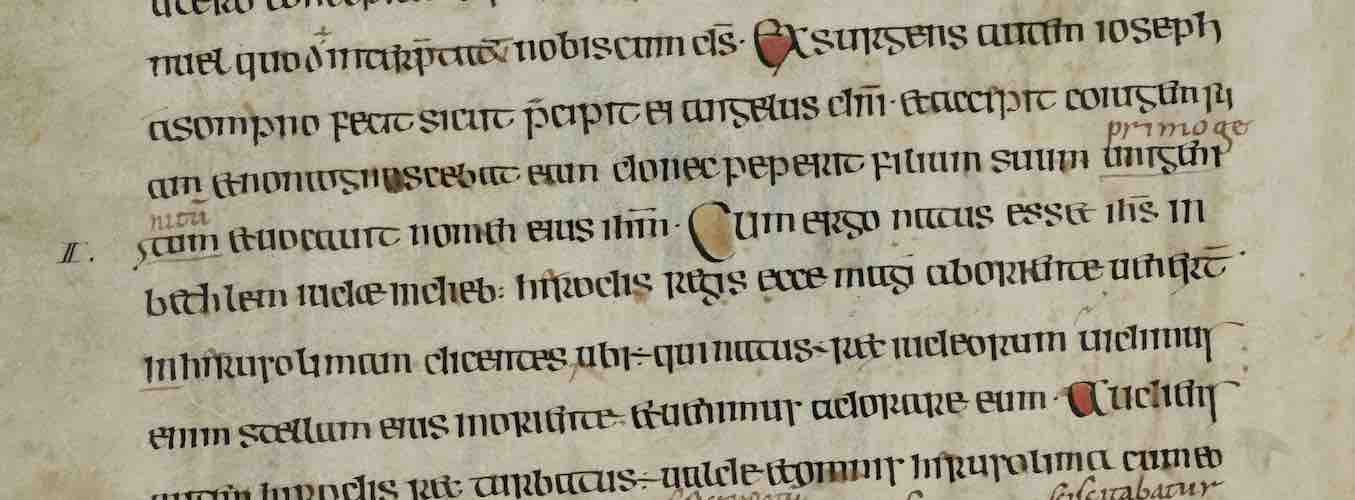Transcribe
Latin Insular - Transcription

Description
Uncial used in early-medieval England, Insular Half-Uncial used in Ireland and early Anglo-Saxon England, and the minuscule scripts of Britain and Ireland. Insular developments in layout and word separation.
Review Insular Letterforms
Whether you are transcribing Insular Half-Uncial or Insular Minuscule, you should bear in mind the letterforms you practiced recognizing in the last unit, when you transcribed late-antique Half-Uncial.
As we mentioned in the Insular Paleography lesson, the Insular scripts mainly derive from Half-Uncial. Both the majuscule and minuscule Insular scripts — although their aspects are very different — use several of the most common Half-Uncial letterforms, notably the 5-shaped g.
As usual, be careful about telling r from tall s, and remember that in Insular scripts the shoulder of r curves down towards the baseline, while the shoulder of s never does. As a result, r is easy to confuse with n and s is easy to mistake for r.


Abbreviations
Insular manuscripts use a number of arbitrary signs of abbreviation derived from Tironian notes, the ancient shorthand system traditionally attributed to Cicero's amanuensis Tiro. These are symbols that represent whole words, without bearing any relationship in shape to the letters of the word in question. The most important of these are:
7 for et (looks like the number 7, sitting low on the line so its tail hangs down below the baseline)
÷ for est (looks like a division sign)
When you expand either of these abbreviations, you should give the whole word in parentheses, because you are supplying every letter of the word the symbol represents. For example, if you see 7 you should transcribe it (et).
Note, though, that the other usual medieval representation of et, the ampersand, is not really an abbreviation; it is just an e and a t written in ligature — written so that the two letters share a stroke and their ductus is changed when the two letters combine. So if you see &, you should just transcribe it et with no parentheses.
There are several other distinctively Insular abbreviations that do not appear in the transcription exercises in this lesson. These include an h with a little tag on its shoulder for autem; a backwards c for con; a backwards Uncial e for eius; and a symbol that looks like a small capital H for enim. Later scribes unfamiliar with Insular abbreviations often misinterpreted them. Textual critics have sometimes been able to demonstrate that a later scribe was working from an Insular exemplar because a mistaken transcription of an Insular abbreviation has worked its way into a text.
Ready to try transcribing some Insular script? Click ahead to try transcribing Insular Half-Uncial.
Exercise 1
Insular Half-Uncial, Ireland ca. 750
Transcribe the first six lines.
In this manuscript, cl looks a lot like d and vice-versa. Note that the bottom of l curves, whereas the upright stroke of d is straight all the way down.
At the end of line 3, what the scribe originally wrote has been corrected in a lighter ink. Don't worry about transcribing the correction. See if you can transcribe just what the original hand wrote.
This scribe's word separation is excellent compared to what we saw in the last unit, but it's far from perfect. Stay alert!
This hand may lead to minim-confusion. Keep an eye on i, m, n, and u, count minims, and don't forget that you need to end up with Latin that makes sense.
Watch out for those nomina sacra!
Transcription Answer
2. quam conuenirent inuenta (est) in utero habens de sp(irit)u s(an)c(t)o
3. JOSeph autem uir eius cum esset homo iustus et noluit
4. eam traducere sed uoluit occulte dimittere eam· Haec
5. eo cogitante ecce angelus d(omi)ni in sompnis apparuit ei
6. dicens ioseph filii dauid noli timere accipire mariam
Exercise 2
Iona, between 688 and 713 CE
Transcribe the end of line 8 to the beginning of line 26 from the second column.
This scribe uses a form of ae ligature that looks like an e with a little tag that looks like part of a u hanging off its left side (as for example in the first two words in line 20). You may just transcribe this ae, or if you can type the ligature, æ. Do not treat it as an abbreviation.
The abbreviation at the end of line 19 is for q(uam). We will learn more about the p- and q- abbreviations in future lessons. Their use in Insular manuscripts is eccentric.
As in the previous manuscript, watch out for d that looks like cl.
8
9
10
11
12
13
14
15
16
17
18
19
20
21
22
23
24
25
26
Schaffhausen, Stadtbibliothek, Gen. 1, p. 2. (www.e‑codices.unifr.ch)
Transcription Answer
9. lu(m)ba eteni(m) semplex et
10. innocens (est) auis· hoc itaq(ue)
11. uocamine et homo sem(-)
12. plex innocensq(ue) nuncupa(-)
13. ri debuit· qui in se colu(m)
14. binis morib(us) sp(irit)ui s(an)c(t)o hos(-)
15. pitiu(m) præbuit· Cui nomi(-)
16. ni non inconuenienter
17. congruit illud· quod in
18. prouerbiis scriptum (est)
19. Melius (est) nomen bonu(m) q(uam)
20. diuitiæ multæ· Hic igi(-)
21. tur noster præsul non
22. inmerito non solu(m) a die(-)
23. bus infantiæ hoc uoca(-)
24. bulo d(e)o donante ad(-)
25. ornatus proprio dita(-)
26. tus est ’